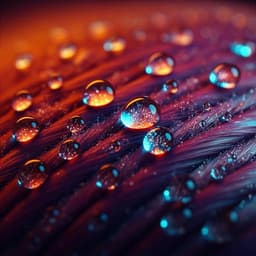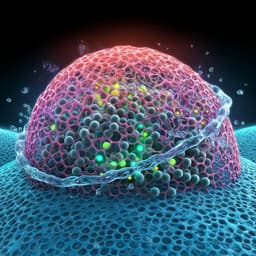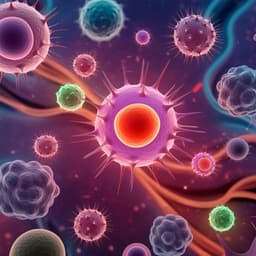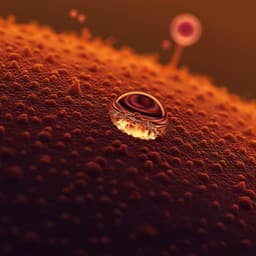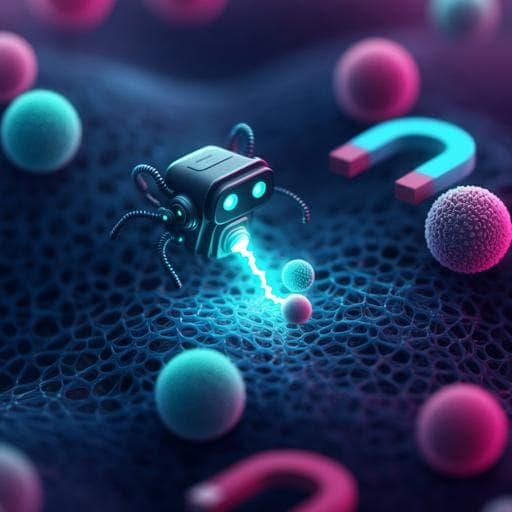
Medicine and Health
Water-powered self-propelled magnetic nanobot for rapid and highly efficient capture of circulating tumor cells
R. D. Wavhale, K. D. Dhobale, et al.
Discover a groundbreaking magnesium·Fe₃O₄-based Magneto-Fluorescent Nanorobot that self-propels in blood, enabling the nearly perfect isolation of cancer cells. Developed by Ravindra D. Wavhale and team at the Maharashtra Institute of Medical Education and Research, this innovative technology shows exceptional efficiency in capturing cancer cells, particularly MCF7 breast cancer cells, in serum and whole blood.
~3 min • Beginner • English
Introduction
Self-propelled micro/nanobots offer unique advantages for biomedical tasks but many reported systems rely on non-biocompatible fuels (e.g., H2O2, strong acids/bases, halogens), limiting in vivo or clinical use. A key challenge is developing water-driven, biocompatible propulsion enabling advanced mobility and specific cell recognition rapidly in complex biological fluids. This study addresses that need by creating water-powered magnesium-based Janus nanobots with magnetic guidance and ligand-directed targeting to selectively capture circulating tumor cells (CTCs) directly from biological media, including whole blood, without added toxic fuels. The research hypothesis is that autonomous propulsion in water, combined with magnetic steering and specific biomolecular ligands (EpCAM antibody or transferrin), will markedly improve encounter rates and binding kinetics to CTCs, yielding rapid and highly efficient cell capture.
Literature Review
The work is positioned against prior micro/nanobot systems that typically require non-biocompatible fuels (H2O2, acidic/alkaline media, halogens), which hinder practical biomedical application. The authors argue water is the ideal fuel for biocompatibility but fabricating versatile water-driven bots capable of complex biological functions, such as rapid and specific cell recognition in realistic media, remains challenging. The study builds on Janus nanostructures integrating catalytic propulsion and magnetic navigation, and on ligand-mediated capture strategies (e.g., EpCAM, transferrin), aiming to overcome diffusion-limited binding by active motion in physiological environments.
Methodology
Design and fabrication: Janus MFNs were produced by coating Mg nanoparticles with a hemispherical Fe3O4 shell to enable magnetic actuation. One side of the Mg core was chemically functionalized with glutathione (GSH), PAMAM G4 dendrimers (for multivalent conjugation), Cy5 dye (for fluorescence), and targeting ligands—either anti-EpCAM monoclonal antibody (Ab) or transferrin (Tf). Surface conjugations employed EDC/NHS chemistry and appropriate buffers. The resulting constructs were Mg-Fe3O4-GSH-G4-Cy5-Tf and Mg-Fe3O4-GSH-G4-Cy5-Ab.
Characterization: Transmission electron microscopy (TEM) and EDX mapping confirmed Janus morphology (Mg core with asymmetric Fe3O4 cap) and elemental composition (Mg, Fe, O); particle size by TEM ~20 nm, hydrodynamic size 62.3 ± 3.3 nm (DLS). FTIR verified stepwise conjugation: Fe–O stretches at 578 and 667 cm−1; amide/N–H features confirming G4 conjugation; additional amide bands upon Tf/Ab attachment. Zeta potential measurements showed progressive shifts with each conjugation step (e.g., approximately −4.39, −2.55, −0.42, and −6.51 mV across intermediates), and fluorescence spectra confirmed Cy5 incorporation. Magnetic response was assessed by accumulation near magnet gradients and controlled movement under an external magnetic field.
Propulsion studies: Autonomous motility was quantified in PBS, DMEM, and serum, with and without NaHCO3 supplementation. Motion arises from the Mg–water reaction: Mg + 2H2O → Mg(OH)2 + H2, generating H2 bubbles that provide thrust and buoyancy; Fe3O4 enables magnetic guidance. NaHCO3 assists propulsion by dissolving the passivating Mg(OH)2 layer (Mg(OH)2 + 2HCO3− → MgCO3 + 2H2O), sustaining reaction kinetics. Speeds and trajectories were recorded by optical tracking; upward-downward cyclic motion observed due to bubble nucleation, growth, and release. Lifetimes were evaluated; the hemispherical Fe3O4 shell’s small opening controlled Mg dissolution, prolonging activity. Additional propulsion data at alkaline conditions (1.0 M NaOH) were recorded for speed estimation.
Cell capture assays (in vitro): MFNs were incubated with HCT116 (colon carcinoma) and MCF7 (breast cancer) cells in PBS, DMEM, whole blood, and lysed blood, with and without added NaHCO3. After brief incubation (minutes), magnetic separation isolated MFN-bound cells. Capture efficiency was evaluated across spiked CTC concentrations (10–100 cells mL−1; also as low as 1 cell mL−1), with fluorescent imaging and immunostaining (Hoechst, FITC/PE-labeled anti-cytokeratin for CTCs; PE anti-CD45 for leukocytes) to identify Hoechst+/CK+/CD45− CTCs. Controls included nanobots without Ab/Tf ligands to assess specificity and the role of propulsion.
Clinical validation: Peripheral blood (1 mL) from five epithelial cancer patients was tested. Samples were incubated with MFNs for 5 minutes, magnetically separated, and subjected to immunocytochemistry (CK, CD45, Hoechst). CTC counts per mL were recorded.
Instrumentation: TEM (Technai FEG 2, 300 kV), DLS (HORIBA SZ-100), FTIR (Perkin Elmer Frontier), UV–Vis (Agilent Cary 60), fluorescence spectroscopy (Agilent Cary-Eclipse), zeta potential (Malvern Zetasizer Nano ZS).
Key Findings
- Structure and size: Janus morphology confirmed with Mg core and hemispherical Fe3O4 shell; TEM size ~20 nm; hydrodynamic size 62.3 ± 3.3 nm. EDX mapping verified Mg, Fe, O distribution. FTIR and fluorescence confirmed successful stepwise conjugations (GSH, G4, Cy5, Tf/Ab). Zeta potentials shifted with each functionalization step (approx. −4.39 → −2.55 → −0.42 → −6.51 mV), supporting conjugation success.
- Dual-mode actuation: MFNs exhibited catalytic self-propulsion in aqueous/biological media and magnetic guidance/steering via Fe3O4. Accumulation at magnet gradients demonstrated remote controllability.
- Propulsion performance: Autonomous upward–downward cyclic motion driven by H2 bubble formation from the Mg–water reaction. Reported speeds included high values in alkaline conditions: ~0.815 ± 0.008 (unit reported as m s−1), 2.007 ± 0.06 mm s−1, and 0.393 ± 0.077 mm s−1 in PBS, DMEM, and serum, respectively, in 1.0 M NaOH. In NaHCO3-assisted conditions, speeds increased with bicarbonate concentration, e.g., PBS: ~0.46–0.82 (reported units ms−1) as NaHCO3 increased 0.25–1.0 M; DMEM and serum showed propulsion even without added NaHCO3 due to endogenous bicarbonate but with smaller speed gains due to protein fouling.
- Lifetime: Average active lifetime ~8 min, ranging from ~1 min to >28 min depending on medium and conditions (e.g., 1.0 M NaOH). Fe3O4 shell aperture controlled Mg dissolution, prolonging operation.
- Capture efficiency (spiked samples): With NaHCO3, MFNs achieved >~93% capture in PBS, DMEM, whole blood, and lysed blood across 10–100 cells mL−1; at very low loads (≈1 cell mL−1), capture ≈100%. Without NaHCO3, capture dropped markedly (e.g., ~38–56% in PBS/DMEM; ≤~67% in whole/lysed blood at low CTC counts). Continuous motion substantially enhanced encounter rates and target-binding kinetics. Controls without Ab/Tf showed minimal capture, confirming ligand specificity and the role of propulsion.
- Cell lines: Both HCT116 and MCF7 cells were efficiently captured; grouped plots and linear regressions showed high linearity (R² ≥ 0.676), with statistically similar slopes across treatments (p < 0.05 threshold reported).
- Clinical samples: In 1 mL peripheral blood from five epithelial cancer patients, MFNs captured 1–5 CTCs mL−1 within 5 minutes. Captured cells were Hoechst+/CK+/CD45− with strong CK18 staining.
- Safety/compatibility: HCT116 cell viability in DMEM with 1.0 M NaHCO3 was assessed up to 60 min (details referenced), supporting short-term compatibility of assay conditions.
Discussion
The study demonstrates that water-powered Mg-based Janus MFNs overcome a key limitation of prior nanomotors by eliminating the need for toxic fuels while operating effectively in complex biological fluids, including whole blood. Autonomous propulsion, aided by NaHCO3-mediated removal of Mg(OH)2 passivation, increases collision frequency and residence time near target cells, thereby accelerating ligand-mediated binding (EpCAM Ab or transferrin targeting). Magnetic guidance adds rapid bulk manipulation and separation, improving workflow speed. The near-quantitative capture at low CTC counts (≈1 cell mL−1) indicates that active motion can shift the capture regime from diffusion-limited to transport-enhanced binding, supporting the core hypothesis. High linearity across spiked concentrations and successful detection in clinical samples (1–5 CTCs mL−1) underscore translational potential for rapid, low-cost CTC isolation and enumeration. While protein fouling in serum/DMEM reduces propulsion gains compared to PBS, MFNs still maintain effective motion due to endogenous bicarbonate and magnetic control, highlighting robustness in physiologic contexts.
Conclusion
This work introduces magneto-fluorescent, water-driven Mg–Fe3O4 Janus nanobots functionalized with GSH, PAMAM G4, Cy5, and targeting ligands (EpCAM antibody or transferrin) that autonomously propel and are magnetically steerable in biological media. MFNs achieve rapid, highly efficient CTC capture, approaching 100% efficiency even at very low cell loads, and demonstrate clinical feasibility by capturing 1–5 CTCs per mL in patient samples within minutes. The architecture’s small Fe3O4 cap aperture modulates Mg dissolution for extended operation, and NaHCO3 enhances propulsion by removing Mg(OH)2 passivation. The platform is modular; ligands can be swapped to target non-epithelial CTCs, toxins, or proteins, suggesting broad in vitro diagnostic and separation applications. Future work should optimize propulsion under physiological protein loads, refine lifetime control, assess biocompatibility and safety comprehensively, and integrate MFNs into standardized clinical workflows with automated magnetic handling and imaging/readout.
Limitations
- Dependence on bicarbonate: Optimal propulsion and capture require sufficient HCO3− to remove Mg(OH)2 passivation; without NaHCO3, capture efficiency drops substantially.
- Medium effects: Protein fouling in serum/DMEM hinders Mg–water reaction and reduces speed compared to PBS, potentially affecting performance variability across patient samples.
- Finite lifetime: Active operation averages ~8 minutes (range up to >28 minutes), limiting prolonged assays without replenishment.
- Reporting inconsistencies: Speed units and some conditions (e.g., NaOH vs. NaHCO3) are inconsistently reported, complicating direct comparison and potentially indicating experimental variability.
- Target scope: Demonstrations focus on EpCAM/Tf-positive cell lines; performance on heterogeneous, EpCAM-low/negative CTCs requires further validation.
- Affinity and off-target binding: While specificity is shown, systematic evaluation of leukocyte binding and rare-cell false positives/negatives in larger clinical cohorts is needed.
Related Publications
Explore these studies to deepen your understanding of the subject.



